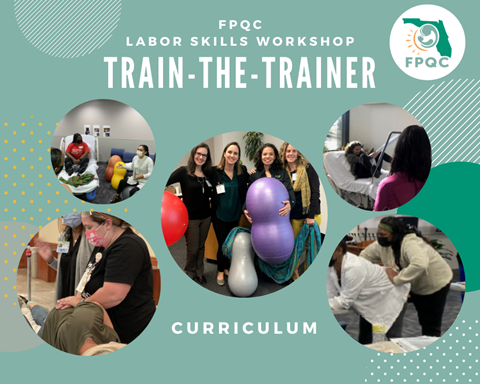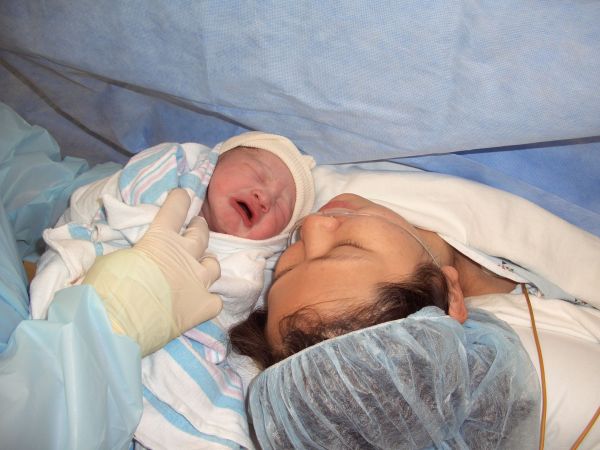Florida Perinatal Quality Collaborative
PROVIDE Initiative

As of June 2022 the PROVIDE Initiative has moved into Sustainability, but we encourage you to download and share our Toolbox Resource List!
Promoting Primary Vaginal Deliveries (PROVIDE)
As the PROVIDE Initiative moves into sustainability, FPQC thanks our hospitals teams for their dedication to lowering NTSV cesareans across the state. As a gift to our teams, we have adapted our popular Labor Support Workshops into a Train-the-Trainer format! View the curriculum here.

Did You Know?
- The Joint Commission will be publishing hospitals with NTSV cesarean rates above 30%
- Medicaid managed care plans want to reduce their provider NTSV cesarean rates by 12% by 2024
- Large cesarean delivery rate reductions does not lead to worsened birth outcomes for mothers or newborns
- Moms are asking for less medical intervention during labor
- ACOG and SMFM define active labor beginning at 6 cm rather than 4 cm
Stakeholders across the state and the U.S. have begun to take note of cesarean delivery rates, including their impact on morbidity, mortality, and health care costs.

Project Goal
The goal of the PROVIDE Initiative is to improve maternal and newborn outcomes by applying evidence-based interventions to promote primary vaginal deliveries at Florida delivery hospitals and ultimately reduce NTSV cesareans.
An analysis of Florida birth certificates showed only one-fifth of the hospitals (21%) meet the Healthy People 2020 national goal for Nulliparous Term Singleton Vertex (NTSV) cesarean section deliveries of 23.9% or less. The primary cesarean delivery rate, which drives the overall cesarean rate, among low-risk first-birth deliveries in Florida ranges from 7.35% to 59.8%. Wide variation suggests clinical practice patterns may contribute and provides an opportunity for improvement.
Initiative Impact
For most low-risk nulliparous, term, singleton, vertex (NTSV) pregnancies, cesarean birth increases risk of hemorrhage, infection, uterine rupture, abnormal placentation, cardiac events, psychological stress, longer hospital stays, increased pain, and increased postpartum re-admissions. Cerebral palsy and neonatal seizure rates have remained unchanged since 1980. Cesareans are associated with impaired neonatal respiratory function, neonatal intensive care unit admission, difficulty breastfeeding, and lifelong health (Main et al 2011; Smith et al 2016).Costs associated with cesareans are significant for insurers, government, taxpayers, and consumers. Studies have shown that each cesarean costs $5,000 to $10,000 more than a vaginal birth. Based on Florida reports, maternal hospital cost savings for each Medicaid and private insurance cesarean delivery would be about $4,000. Primary cesarean deliveries are a major contributor to the large increase in cesarean delivery rates in the United States over the past two decades.
Participation in this initiative helps hospitals work in a collaborative with resources to help you implement evidence-based quality improvement recommendations. It also offers an environment to learn together with others on the best strategies, methods and tools to adapt and implement. Hospitals that participate in multi-organization quality improvement collaboratives achieve more gains faster than those who do so alone. Past participants have found it useful to not have to “reinvent the wheel.”
News & Announcements
-
The PROVIDE Initiative Tool Box contains tool kit documents, algorithms, example policies and educational materials, and more. This resource is updated regularly throughout the project.
Online Tool Box for PROVIDE Hospitals
Newly Added Tool Box Resources:
- FPQC Labor Support Workshop Train-the-Trainer Curriculum
- What Can Florida Hospitals Do to Have California's Results?
- Fall 2021 Mid-Project Meeting presentations
Additional Resources:
-
The FPQC is hard at work creating a library of short videos for the PROVIDE Initiative. Check back for additions!
Julie DeCesare, MD, clinical co-lead of the Florida Perinatal Quality Collaborative's Promoting Primary Vaginal Deliveries (PROVIDE) Initiative, discusses the ARRIVE Trial, and whether or not this should change practice and care in Florida. FPQC Statement on the ARRIVE Trial findings and PROVIDE: https://tinyurl.com/FPQCarrive
Dr. Karen Bruder, clinical co-lead of the Florida Perinatal Quality Collaborative's Promoting Primary Vaginal Deliveries (PROVIDE) Initiative, discusses tips for engaging physicians in your quality improvement project.
Labor Positions with a Peanut Ball
Research shows that use of a peanut ball in labor results in shortened length of labor, and reduced cesarean section rate in epidural patients. We'll walk you through some positions with the peanut ball in the first and second stage of labor. Jessica Brumley, CNM, PhD leads the FPQC's Labor Support Skills to Promote Vaginal Birth Workshops.
Knowing some techniques to rotate a malpositioned baby can help avoid a cesarean. The Miles Circuit is a series of positions that are useful to help get the baby lined up in the Left Occiput Anterior (LOA) Position. Jessica Brumley, CNM, PhD leads the FPQC's Labor Support Skills to Promote Vaginal Birth Workshops.
Why Maternal Positioning Helps Prevent Cesareans
Why does changing positions during labor help deliver a baby vaginally? Jessica Brumley, CNM, PhD leads the FPQC's Labor Support Skills to Promote Vaginal Birth Workshops.
What is an NTSV Cesarean Rate?
Cesarean Rates: What's with all the different types? How are they calculated? Why should we focus on NTSV cesarean rates? Dr. Bill Sappenfield, MD, MPH explains what all the rates mean and why the PROVIDE Initiative focuses on NTSV cesareans.
Let's all get on the same page when it comes to definitions of: - When active labor begins - Induction vs. augmentation - First stage arrest, second stage arrest, and failed induction Dr. Wilbur Hitt shares the standard definitions used by ACOG and the Florida Perinatal Quality Collaborative.
Employer Focus on Reducing Medically Unnecessary Cesareans
Karen van Caulil, President and CEO of the Florida Alliance for Healthcare Value, presents the employer focus on reducing medically unnecessary cesarean sections in Florida.
These videos can be used in a variety of ways! Here are some ideas:
- Use as a way to kick off a PROVIDE team meeting or a department meeting
- Show at OB division meetings where nursing, physician, and C-suite leaders are present to raise awareness of PROVIDE
- Share on social media and promote via your website
- Use at nurse pre-shift briefs
- Show to OB Chief and OB Medical Director and ask for the best way to present the information at their hospital
- Perinatal safety team discussions
- Incorporate into training, education, or events
-
Advent Health Waterman
Advent Health Zephyrhills
AdventHealth Altamonte
AdventHealth Celebration
AdventHealth Daytona Beach
AdventHealth Orlando
AdventHealth Wesley Chapel
AdventHealth Winter Park
AdventHealth Tampa
Ascension Sacred Heart Hospital on the Emerald Coast
Ascension St. Vincent's Clay County
Ascension St. Vincent's Riverside
Ascension St. Vincent's Southside
Baptist Medical Center Beaches
Baptist Medical Center Nassau
Baptist Medical Center South
Bayfront Health Spring Hill
Bayfront Health St. Petersburg Baby Place
Bethesda Hospital Inc.
Boca Raton Regional Hospital
Broward Health Medical Center
Cape Coral Hospital (Lee Health)
Lakeland Regional Hospital
Leesburg Regional Medical Center
Cleveland Clinic Indian River Hospital
Cleveland Clinic Tradition Hospital (Tradition Medical Center)
Fort Walton Beach Medical Center
Halifax Health Medical Center
HealthPark Medical Center (Lee Health)
Hialeah Hospital
Homestead Hospital
Baptist Health South Florida
Jackson North Medical Center
Jackson South Medical Center
JFK Medical Center
Jupiter Medical Center
Kendall Regional Medical Center
Lakeland Regional
Lawnwood Regional Medical
Manatee Memorial Hospital
Mease Countryside Hospital (BayCare)
Memorial Hospital Miramar
Memorial Hospital West
Memorial Regional Hospital
Mercy Hospital (Plantation General Hospital)
Morton Plant Hospital (BayCare)
Mount Sinai Medical Center
Naples Community Hospital
North Florida Regional Medical Center
North Shore Medical Center
Northwest Medical Center
Orange Park Medical Center
Palmetto General Hospital
Palms West Hospital
Parrish Medical Center
Plantation General Hospital
Sacred Heart Hospital Pensacola
Santa Rosa Medical Center
Sarasota Memorial Healthcare System
South Florida Baptist Hospital (BayCare)
South Lake Hospital
South Miami Hospital
St. Joseph's Hospital North (BayCare)
St. Joseph's Hospital South (BayCare)
St. Joseph's Women's Hospital (BayCare)
St. Lucie Medical Center
St. Mary's Medical Center
Tallahassee Memorial Healthcare
Tampa General Hospital
The Women's Hospital at Jackson Memorial Medical Center
UF Health Jacksonville
Wellington Regional Medical Center
West Kendall Baptist Hospital
Winnie Palmer Hospital for Women and Babies
Winter Haven Women's Hospital (BayCare)
-
PROVIDE 2.0 Celebration Webinar - May 4, 2022
Greasing the Machinery to Move the Needle: Cesarean Overuse and the Culture of Care presented by Emily White VanGompel, MD, MPH (Program Director, NorthShore Outcomes Research Network Clinical and Assistant Professor, University of Chicago Pritzker School of Medicine) - December 1, 2021
Pre-Cesarean Checklists - February 26, 2020*
PROVIDE Baseline Data Report and New Web System for Hospitals New to PROVIDE - January 15, 2020
PROVIDE Data for Hospitals Returning to PROVIDE: Reassessment Data Reports - November 21, 2019
PROVIDE Data Collection Information for Hospitals New to PROVIDE - October 30, 2019
*In March 2020 we began holding monthly Coaching Calls, which were not recorded. Please visit our PROVIDE Toolbox for past event presentation resources.
-
PROVIDE 2.0: The Next Generation - May 9, 2019
Change Management and PROVIDE 2.0 - April 11, 2019
Where We Are, Where We Are Going, and Managing the OP Baby - February 14, 2019
The Safety and Benefits of Outpatient Cervical Ripening - December 13, 2018
Improving and Sharing Data - October 11, 2018
The Early Labor Walking Path: A Tool to Reduce Admission in Early Labor and Reduce Primary Cesarean Section - August 9, 2018
Second Stage of Labor: Push it Real Good - June 14, 2018
Intermittent Auscultation for Low Risk Women - May 10, 2018
Lessons Learned from Implementing an Induction Policy - March 8, 2018
Overcoming Resistance to Change - February 8, 2018
Where to Start - January 11, 2018
Finding Your Cesarean Reduction Opportunities (PROVIDE Data) - November 9, 2017